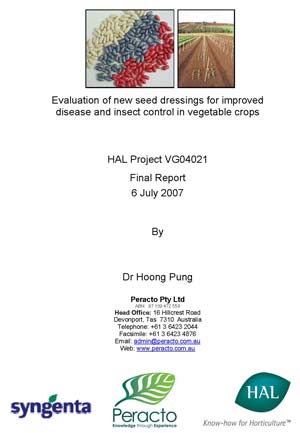|
|
Seed treatment is the most cost-effective disease and pest control method on seed and seedlings, applied at a stage when they are most vulnerable to attack by pathogens and insect pests. Seed dressings use only a small amount of chemical, so even though the new chemicals are more expensive, their use in new seed dressings is still affordable to growers. Currently, most vegetable seed treatments rely on old broad-spectrum chemicals, such as thiram, which are indiscriminate in their target organism and could be removed from use eventually. In recent years, new chemicals that are safer and can better target pests and diseases are being developed for use in broad-acre crops like wheat and canola. This project is a two-year feasibility study conducted in 2005 and 2006 to evaluate new seed dressings in vegetable crops from the major vegetable groups of legumes (green peas and green beans), brassicas (cauliflower) and curcubits (pumpkin).
Six new fungicide dressing formulations containing the active ingredients azoxystrobin, fludioxonil, metalaxyl-M and difenconazole, and two new insecticide seed dressings with abamectin or thiamethoxam, were examined at different rates to identify the appropriate concentrations for use on the different vegetable groups. These new seed dressings were compared against untreated control seeds and thiram treated seeds. This project identified two new fungicide seed dressings, containing the active ingredients, azoxystrobin + fludioxonil + metalaxyl and fludioxonil + metalaxyl, as suitable replacements for thiram seed dressings on the major vegetable crops of green peas, green beans, pumpkin (curcubits) and cauliflowers (brassicas). Seed safety tests showed that the new fungicide and insecticide seed dressings mostly have no phytotoxic effects on garden pea, green bean, cauliflower and pumpkin seeds. Generally, the new fungicide seed dressing treatments containing azoxystrobin, fludioxonil, metalaxyl and difenconazole tend to increase seedling growth, with increased average fresh shoot weights in comparison to the untreated control and the thiram seed treatment. There was also no obvious decline in seed viability as a result of the new fungicide seed treatments in pea, bean, pumpkin and cauliflower treated seeds after a 10-month storage period. This is important, because in practice, treated seeds are often not used immediately after treatment, and can be stored for up to one year before use. The assistance of Tasmanian bean growers, Garry McNab and Chris Russell of Simplot Australia Pty Ltd, Darren Briggs of McCain Food (Aust) Pty Ltd, and Lyndon Butler of Forthside Research Station, in field trial studies, is gratefully acknowledged. We are grateful to Henderson Seed Group Pty Ltd, McCain Food (Aust) Pty Ltd and Simplot Australia Pty Ltd for providing vegetable seeds for trial studies in this project. Peracto Pty Ltd staff, who also contributed to this project included Phillip Frost, Sarah Flynn, Kate Williams, David Kohler and Warrick Barnes. This project has been facilitated by Horticulture Australia Limited, and has been funded by voluntary contributions from Syngenta Crop Protection Pty Ltd. The Australian Government provides matching funding for all of Horticultural Australias Research and Development activities. |
||||||
|

